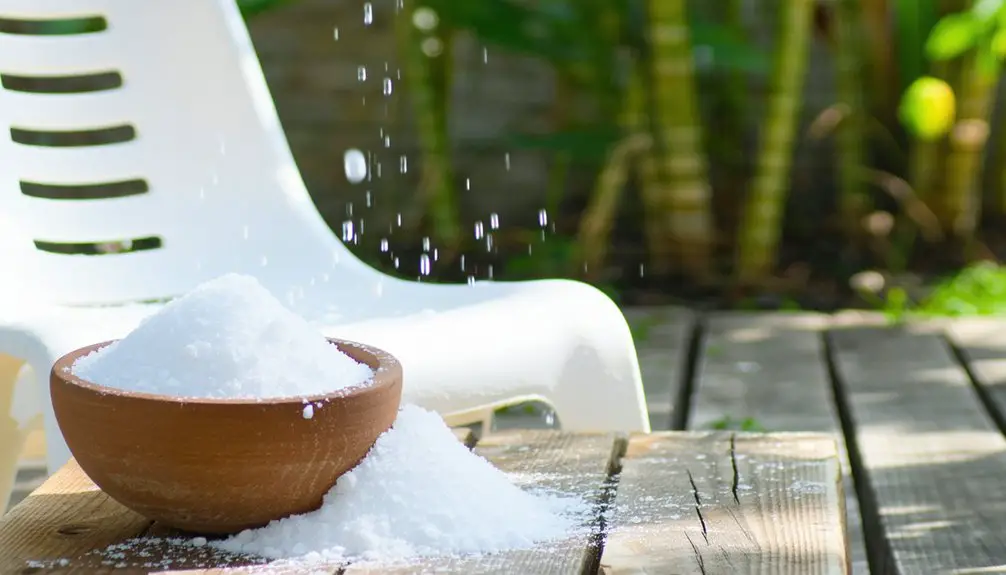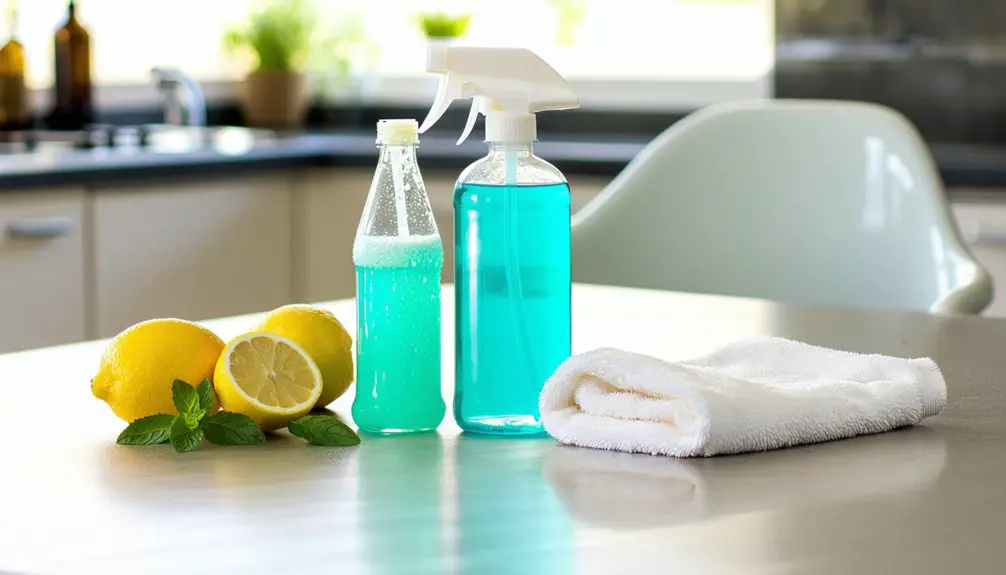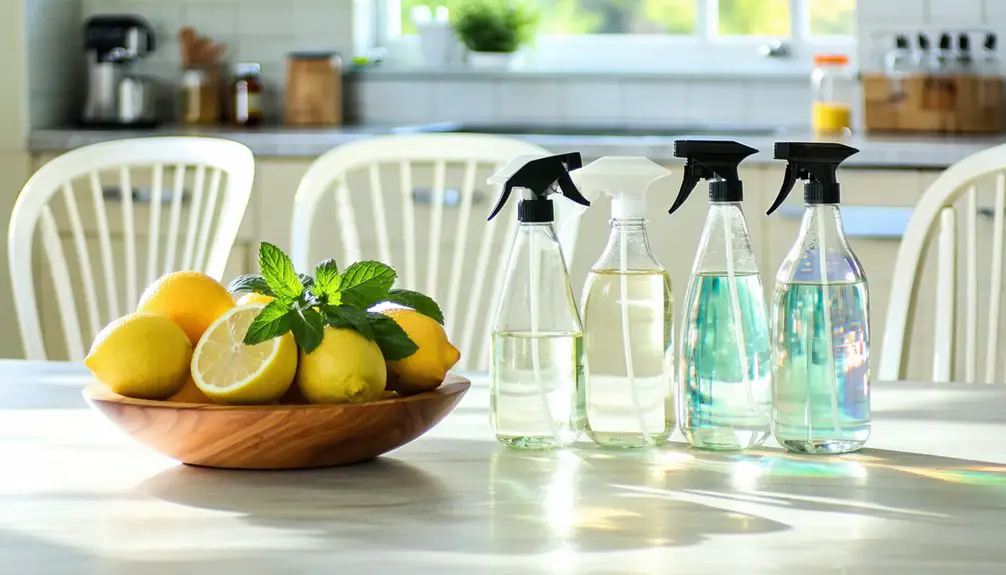You can easily clean your plastic furniture using simple DIY solutions from your kitchen. For white furniture, mix 1/4 cup of bleach with warm water, but avoid color-treated plastics. If you prefer an eco-friendly option, combine 1/4 cup of white vinegar with warm water. Baking soda works wonders too; just sprinkle it on a wet surface and scrub gently. Another effective method involves mixing 1 gallon of water with 1 tablespoon of laundry detergent. Finally, try combining water, Castile soap, and essential oils for a fresh scent. There's still more to discover about keeping your furniture spotless!
Key Takeaways
- Use a bleach solution (1/4 cup bleach with warm water) for deep cleaning white plastic furniture, but avoid colored plastics.
- For an eco-friendly option, mix 1/4 cup white vinegar with warm water to clean without damaging plastic.
- Apply baking soda after wetting the surface; let it sit for five minutes before scrubbing for tough stains.
- Create a laundry detergent solution (1 tablespoon in 1 gallon warm water) for gentle cleaning; rinse thoroughly afterward.
- Combine Castile soap, water, and optional essential oils for a natural cleaning mix that keeps furniture fresh and clean.
Bleach Cleaning Solution
When it comes to deep cleaning plastic furniture, bleach can be a powerful ally. It effectively removes stains, debris, grime, and grease, making your white plastic furniture look new again. However, you should avoid using bleach on colored plastic, as it can fade or discolor the surfaces. Regular cleaning helps prolong the lifespan of plastic furniture, so it's essential to incorporate safe cleaning agents into your routine. For optimal results, apply the bleach solution on a cloudy day or in a shaded area to minimize the impact of UV rays on the cleaning process.
Remember, bleach isn't meant for routine cleaning; reserve it for those tougher cleanup jobs.
When using bleach, safety is key. Always wear protective rubber gloves to shield your skin, and dilute bleach with water—mixing 1/4 cup of bleach per bucket of warm water. Never mix bleach with vinegar or other harsh chemicals, as this can create dangerous fumes. Regularly cleaning plastic furniture with mild soap and warm water helps prevent dirt buildup and reduce the need for harsh chemicals.
Rinse your furniture thoroughly with a power or garden hose to ensure all bleach is removed, and let it air dry in the sun or wipe it down with a soft towel to prevent water spots.
Be mindful of the environmental impact of bleach. Excessive use can contaminate water and soil, and its release can harm aquatic life and human health.
Use bleach judiciously to minimize these risks, and consider alternative cleaning solutions for regular maintenance.
Vinegar-Based Cleaning Method
For a more natural and eco-friendly approach to cleaning plastic furniture, try a vinegar-based solution.
Start by gathering your materials: white vinegar, warm water, a bucket or container, a scrub brush, and a soft towel or yard hose for rinsing and drying.
To mix the solution, combine 1/4 cup of white vinegar with warm water in your bucket. Depending on how dirty your furniture is, you can adjust the ratio or even use equal parts water and vinegar for tougher stains. Cleaning vinegar is also a great option for more intense cleaning tasks, as its higher acetic acid content can tackle tougher grime effectively.
Avoid using undiluted vinegar, as its acidity can damage the plastic.
When you're ready to clean, dip the scrub brush into the solution and begin scrubbing the areas with the most scuffs and stains.
Make sure to follow the texture of the plastic to prevent scratches, using gentle to moderate pressure based on the level of dirt.
After cleaning, rinse the furniture with a yard hose or wipe it down with a soft towel.
You can also leave it outdoors in the sun to dry.
Regularly cleaning with this vinegar solution not only prevents stubborn stains but also helps eliminate odors, keeping your plastic furniture fresh.
Baking Soda Application

To effectively clean your plastic furniture, start by wetting the surface, which helps the baking soda adhere better and enhances its cleaning power. Before you apply the baking soda, ensure the area is clear of loose dirt to prevent spreading it around. For colored plastic, it's wise to spot-test first to avoid any discoloration.
Once you're ready, sprinkle a generous amount of baking soda evenly over the entire surface. Use a soft brush or non-abrasive sponge to scrub the baking soda into the furniture. If you're dealing with deep-seated dirt or odors, apply the baking soda liberally. For tougher stains, you can create a paste by mixing baking soda with water and applying it directly to the stains. Regular maintenance can help keep your plastic furniture in great condition.
Here are some tips to keep in mind:
- Let the baking soda sit for at least five minutes.
- Use moderate pressure while scrubbing to avoid scratches.
- Rinse thoroughly to remove all baking soda and dirt.
- Allow the furniture to air dry completely.
Following these steps will leave your plastic furniture looking clean and fresh!
Laundry Detergent Approach
If baking soda isn't cutting it for your plastic furniture, the laundry detergent approach can be an effective alternative.
Start by mixing 1 gallon of lukewarm or warm water with 1 tablespoon of laundry detergent. Before you dive in, make sure to wear protective rubber gloves to shield your hands from chemicals.
Grab a soft sponge or a soft-bristled scrub brush to prevent any damage to the furniture.
Dip your sponge or brush into the cleaning solution and apply it to the plastic surface, focusing on stained or grimy areas. Gently scrub the entire surface to ensure thorough cleaning, but don't let the solution sit for more than ten minutes, especially on colored furniture, to avoid fading. Regular cleaning prevents dirt and stain buildup, ensuring your furniture remains in top condition.
Once you've scrubbed every inch, rinse the furniture thoroughly using a garden or power hose. This step is crucial to remove any residue that could cause streaks.
After rinsing, pat the furniture dry with a clean towel or microfiber cloth, or let it air dry in the sun. Just make sure it's completely dry before using it again to prevent unsightly water spots.
Essential Oils and Soap Mix

Many people find that using an essential oils and soap mix can elevate their cleaning routine for plastic furniture. This method not only cleans effectively but also leaves a refreshing scent.
To create your own solution, gather these ingredients:
- 1 cup water
- 1-2 tablespoons Castile soap
- A few drops of essential oils (like lemon or lavender)
- Baking soda (optional for extra scrubbing power)
Start by mixing the water and Castile soap in a bucket or mason jar. If you choose to add baking soda, combine it with the soap for a more powerful cleaning effect.
Next, add your desired essential oils for fragrance. For a stronger solution, you can substitute white vinegar for water. Stir the mixture well to ensure everything's blended. Regularly using homemade cleaners is cost-effective and reduces your spending on commercial products.
When applying, use a sponge or cloth to gently scrub the plastic furniture, focusing on any stained areas. Rinse the furniture with a hose after cleaning, and let it air dry or wipe it down with a clean cloth.
Regular maintenance helps keep your furniture in top condition and prevents dirt accumulation. Enjoy your freshly cleaned space!
Frequently Asked Questions
Can I Use These Solutions on Painted Plastic Furniture?
You can use white vinegar or mild dishwashing liquid on painted plastic furniture, but avoid bleach and ammonia-based cleaners. Always test solutions on a small area first to prevent any unwanted damage or discoloration.
How Often Should I Clean My Plastic Furniture?
You should clean your plastic furniture about four times a year. If it's in a high-traffic area, consider cleaning more often. Regular maintenance keeps it looking great and extends its lifespan.
Are These Solutions Safe for Indoor Use?
Yes, these solutions are safe for indoor use. Just wear gloves, ensure good ventilation, and test any cleaner on a small area first. Avoid harsh chemicals and scrubbers to protect your furniture's surface.
What Should I Do if Stains Persist?
If stains persist, try soaking the affected area in a warm soap solution for 30 minutes. Use a soft brush to scrub gently, or apply a stronger cleaner specifically designed for tough stains.
Are There Any Eco-Friendly Alternatives to These Cleaning Solutions?
You can try using eco-friendly alternatives like vinegar, baking soda, or essential oils. These ingredients not only clean effectively but also minimize environmental impact. Mix them for a powerful, sustainable cleaning solution you'll love.

